Coronavirus (COVID-19): modelling the epidemic (issue no. 34)
Latest findings in modelling the COVID-19 epidemic in Scotland, both in terms of the spread of the disease through the population (epidemiological modelling) and of the demands it will place on the system, for example in terms of health care requirement
Coronavirus (COVID-19): modelling the epidemic in Scotland (Issue No. 34)
Background
This is a report on the Scottish Government modelling of the spread and level of Covid-19. This updates the previous publication on modelling of Covid-19 in Scotland published on 7 January 2021. The estimates in this document help the Scottish Government, the health service and the wider public sector plan and put in place what is needed to keep us safe and treat people who have the virus.
This edition of the research findings focuses on the epidemic as a whole, looking at estimates of R, growth rate and incidence as well as local measures of change in the epidemic.
Key Points
- The reproduction rate R in Scotland is currently estimated as being between 1.0 and 1.4. This is an increase compared to last week.
- The number of new daily infections for Scotland is estimated as being between 89 and 262, per 100,000 people.
- The growth rate for Scotland is estimated as being between 0% and 6%.
- A higher proportion of those thought to have the new variant[1] are in the two least deprived groups and are aged 20-24.
- The risk of being admitted to hospital with the new variant appears the same as for non-new variant cases. Individuals with a weak positive result are at a lower risk of being admitted to hospital.
- Modelled rates per 100K indicate that by the week of 24 - 30 January 2021, 30 (up 2 from last week) local authorities have at least a 75% probability of exceeding 50 cases, 29 (up 1) of those have at least a 75% probability of exceeding 100 cases, 22 (up 1) of those have at least a 75% probability of exceeding 300 cases and 13 (down 2) have at least a 75% probability of exceeding 500 cases. This is similar to the position last week. The probability of exceeding will be effected by the lockdown as well as by how much new variant is present in a local authority area. This adds to the uncertainty around this modelling this week.
Overview of Scottish Government Modelling
Epidemiology is the study of how diseases spread within populations. One way we do this is using our best understanding of the way the infection is passed on and how it affects people who catch it to create mathematical simulations. Because people who catch Covid-19 have a relatively long period in which they can pass it on to others before they begin to have symptoms, and the majority of people infected with the virus will experience mild symptoms, this “epidemiological modelling” provides insights into the epidemic that cannot easily be measured through testing e.g. of those with symptoms, as it estimates the total number of new daily infections and infectious people, including those who are asymptomatic or have mild symptoms.
Modelling also allows us to make short-term forecasts of what may happen with a degree of uncertainty. These can be used in health care and other planning. The modelling in this research findings is undertaken using different types of data which going forward aims to both model the progress of the epidemic in Scotland and provide early indications of where any changes are taking place.
Modelling outputs are provided here on the current epidemic in Scotland as a whole, based on a range of methods. Because it takes a little over three weeks on average for a person who catches Covid-19 to show symptoms, become sick, and either die or recover, there is a time lag in what our model can tell us about any re-emergence of the epidemic and where in Scotland this might occur. However modelling of Covid deaths is an important measure of where Scotland lies in its epidemic as a whole. In addition, the modelling groups which feed into the SAGE consensus use a range of other data along with deaths in their estimates of R and the growth rate. These outputs are provided in this research findings. The type of data used in each model to estimate R is highlighted in Figure 1.
A short term forecast and projection of the number of cases, ICU and hospital bed demand is also provided at this stage of the epidemic in Scotland.
It should be noted that this research findings covers a period of uncertainty with the growth of the new variant in Scotland (SARS-CoV-2 VUI 202012/01). The percentage of cases composed of this new variant is increasing in Scotland, from 49.7% in the 24 hour reporting period from 3 to 4 January to 62% from 10 to 11 January 2021[2]. It is very likely that this strain will further increase in dominance in Scotland.
Although these research findings include the initial effects of the stay-at-home lockdown in Scotland announced on 4 January, changes associated with the restrictions will not be seen fully for another two weeks.
Analysis of risk of hospitalisation for those who have the new variant (testing positive with S gene deletion, which is a proxy for the new variant) has been included.
What the modelling tells us about the epidemic as a whole
The various groups which report to the Scientific Pandemic Influenza Group on Modelling (SPI-M) use different sources of data in their models (i.e. deaths, hospital admissions, cases) so their estimates of R are also based on these different methods. SAGE’s consensus view across these methods, as of 13 January, was that the value of R in Scotland was between 1.0 and 1.4 (see Figure 1). The value of R on 6 January was between 0.9 and 1.3.
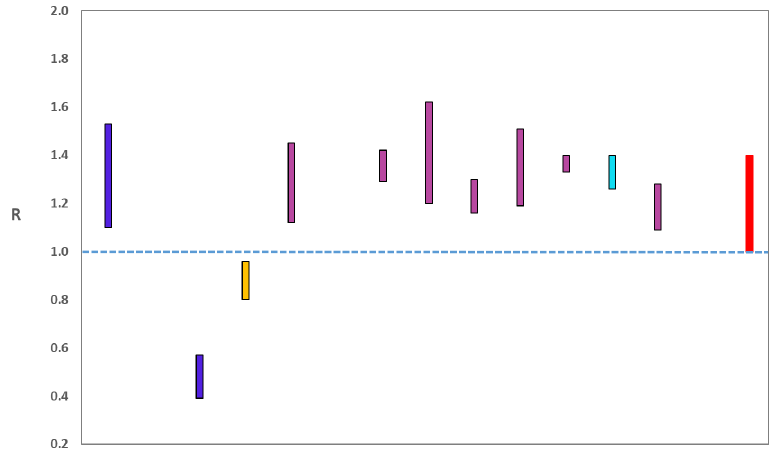
Source: Scientific Advisory Group for Emergencies (SAGE).
The various groups which report to the Scientific Pandemic Influenza Group on Modelling (SPI-M) use different sources of data in their models to produce estimates of incidence (Figure 2). SPI-M’s consensus view across these methods, as of 13 January, was that the incidence of new daily infections in Scotland was between 89 and 262 new infections per 100,000. This equates to between 4,900 and 14,300 people becoming infected each day in Scotland.
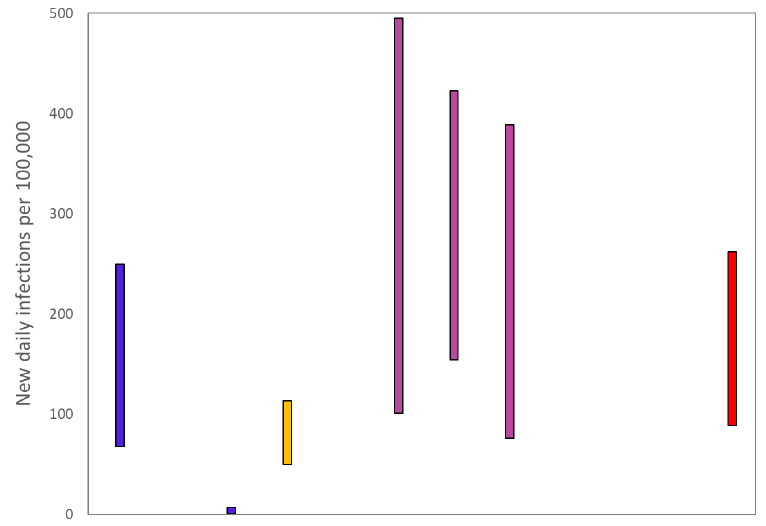
Source: Scientific Pandemic Influenza Group on Modelling (SPI-M).
The consensus from SAGE for this week is that the growth rate in Scotland is between 0 and 6% per day. On 6 January the growth rate was in the range -2% and 5%.
The logistical model developed by Scottish Government to assess implications for health care demand (see previous Research Findings) has been adapted to produce a short/medium-term prediction of infections.
Figure 3 shows a projection that assumes the R value is rising as the new more transmissible variant spreads.
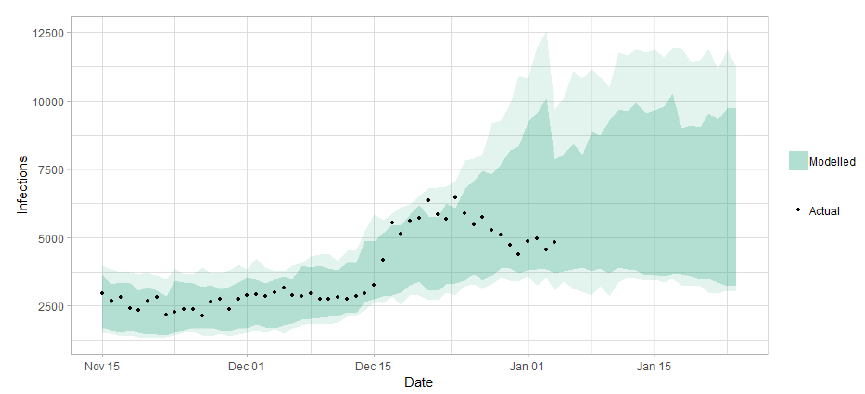
What the modelling tells us about Hospital bed and ICU bed demand
Figure 4 shows the impact of the projection on the number of people in hospital.
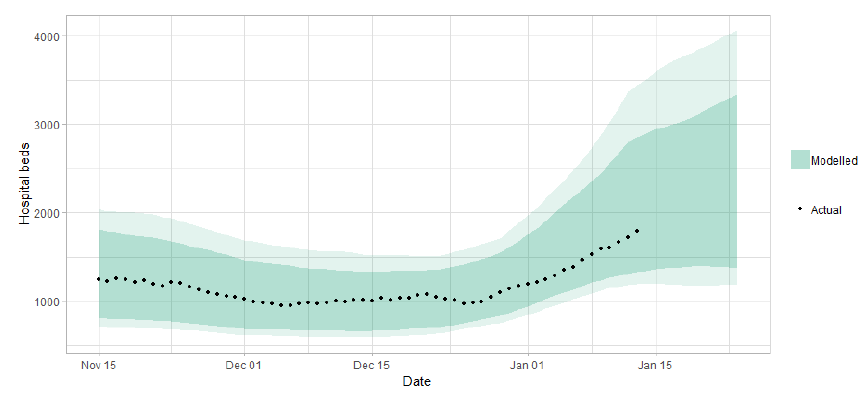
Figure 5 shows the impact of the projection on ICU bed demand.
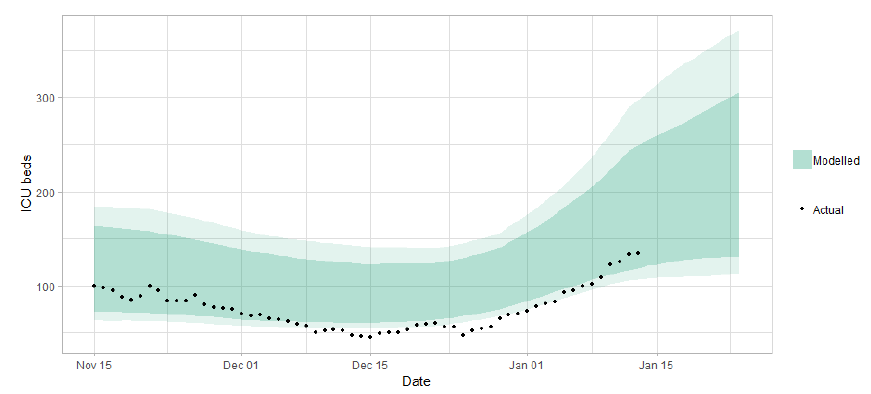
What the modelling tells us about projections of hospitalisations in the medium term
SAGE produce projections of the epidemic[4] (Figure 6), combining estimates from several independent models (including the Scottish Government Government’s logistics modelling, as shown in figures 3, 4 and 5). These projections are not forecasts or predictions. They represent a scenario in which the trajectory of the epidemic continues to follow the trends that were seen in the data up to 11 January and do not account for the impact of future policy or behaviour changes. Nor do they include seasonal effects that might increase transmission.
The delay between infection, developing symptoms, hospitalisation and death means the projections cannot fully reflect changes in transmission that might have occurred over the past two to three weeks.
Beyond two weeks, the projections become more uncertain with greater variability between individual models. This reflects the large differences that can result from fitting models to different data streams, and the influence of small deviations in estimated growth rates and current incidence.
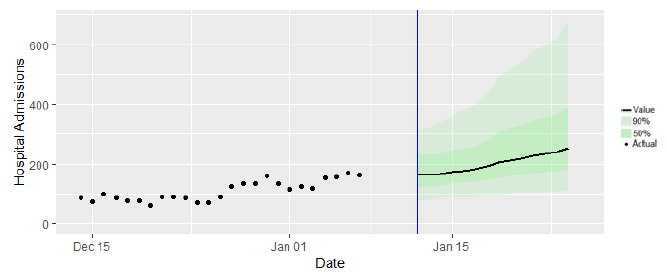
What we know about the risk of hospitalisation from the new variant
The Early Pandemic Evaluation and Enhanced Surveillance of COVID-19 (EAVE) 2 Study Group[5] linked individual patient-level data from all primary, secondary, mortality and virological/serological testing data in Scotland (see Technical Annex). They used this national dataset to investigate the temporal progression of COVID-19 in the Scottish population and the development of COVID-19 morbidity and mortality in individuals.
A higher proportion of those thought to have the new variant[6] are in the two least deprived groups (Figure 7). The age distributions are quite similar (Figure 8) but with a greater proportion of weak positive samples among children aged 0-19, a greater proportion of those thought to have the new variant are aged 20-24.
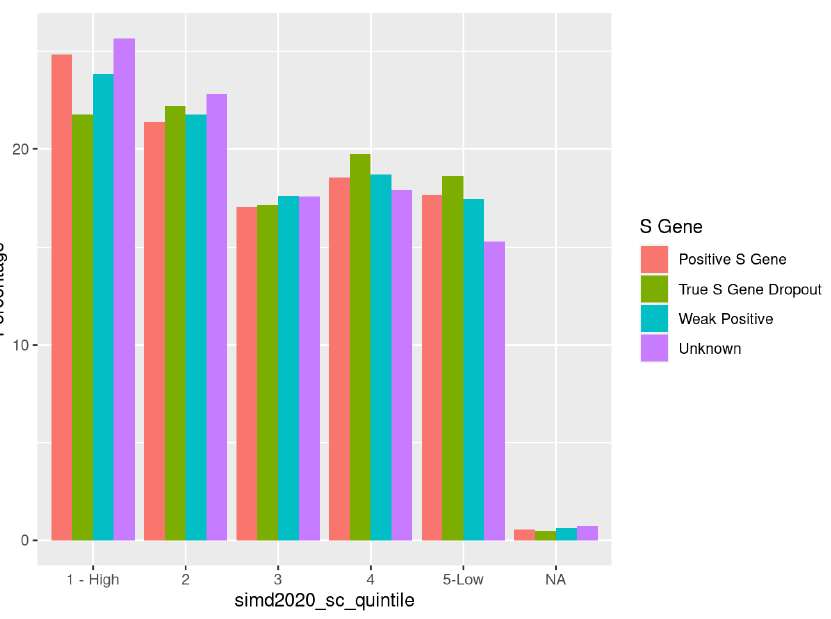
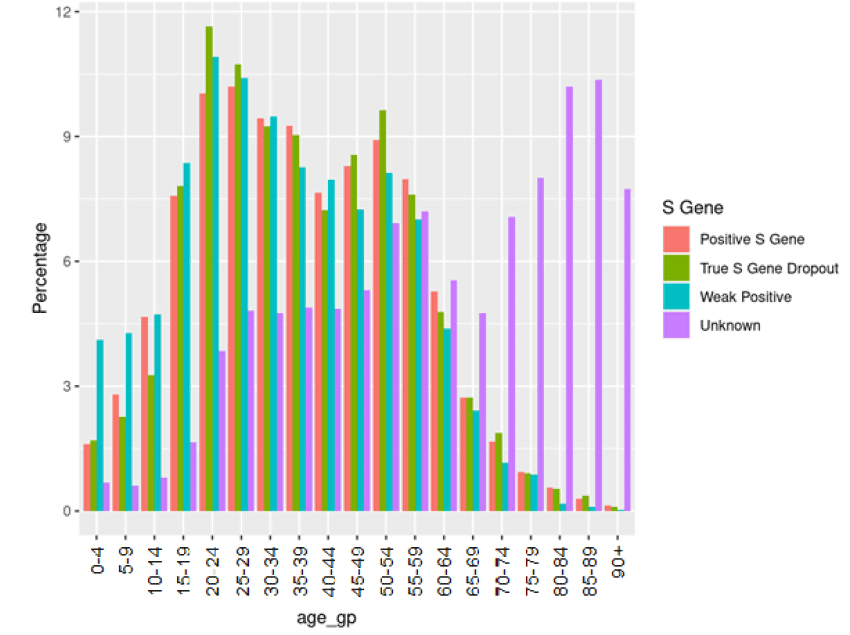
Within the EAVE-II GP data there is information on the presence of 26 clinical risk groups - such as Asthma, Diabetes, Chronic Respiratory Disease and Dementia. They are summarised in a number of clinical risk groups coded as 0, 1, 2, 3-4 and 5+ as a summary measure of multi morbidity. There is not a large difference in the distribution of these risk groups between those with the new variant and non-new variant cases.
The risk of hospitalisation following a positive test result has been estimated and individuals with the new variant are not at increased risk of hospitalisation compared to those with the non-new variant. Individuals with a weak positive result are much less likely to be admitted to hospital. These are preliminary results and the analyses will be updated in the coming weeks.
What we know about which local authorities are likely to experience high levels of Covid
We use modelling based on Covid cases and deaths[9], conducted by Imperial College London, to give us an indication of whether a local authority is likely to experience high levels of Covid in the future. An area is defined as a hotspot if the two week prediction of cases (positive tests) per 100K population are predicted to exceed a threshold, e.g. 500 cases. See technical annex in issue 24.
Modelled rates per 100K (Figure 9) indicate that by the week of 24 - 30 January 2021, 30 (up 2 from last week) local authorities have at least a 75% probability of exceeding 50 cases, 29 (up 1) of those have at least a 75% probability of exceeding 100 cases, 22 (up 1) of those have at least a 75% probability of exceeding 300 cases and 13 (down 2) have at least a 75% probability of exceeding 500 cases. The probability of exceeding will be affected by the lockdown as well as by how much new variant is present in a local authority area. This adds to the uncertainty around this modelling this week.
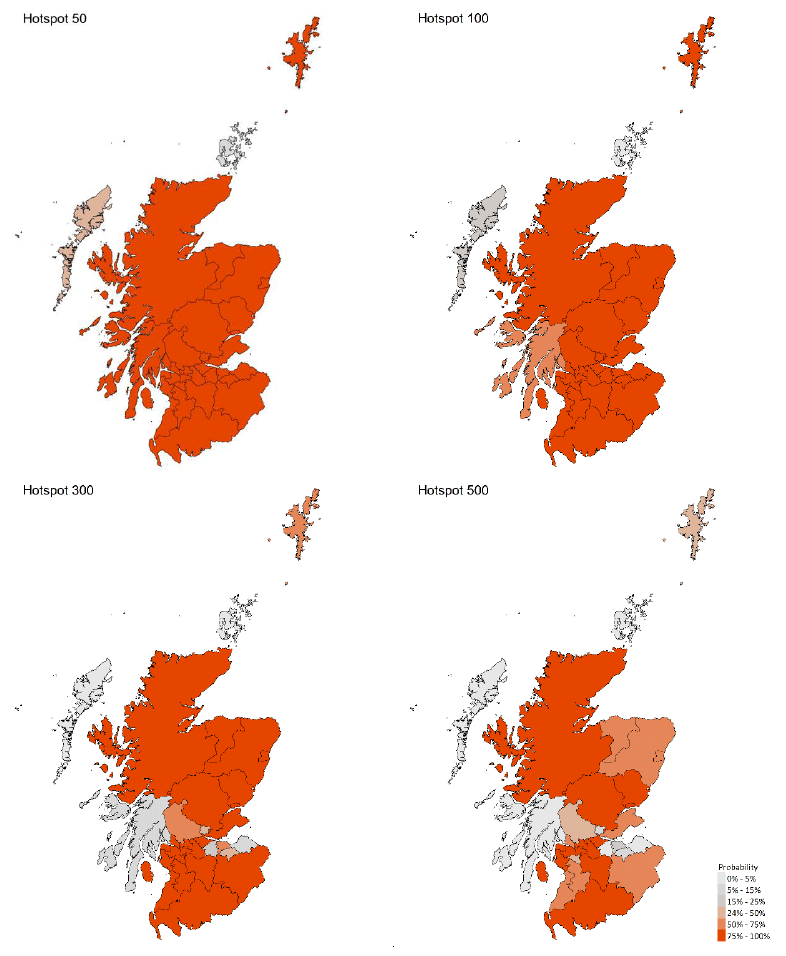
What can analysis of wastewater samples tell us about local outbreaks of Covid-19 infection?
Levels of Wastewater SARS-CoV-2 RNA collected at 28 sites around Scotland are adjusted for population and local changes in intake flow rate and compared to daily 7-day average positive case rates derived from Local Authority and Neighbourhood (Intermediate Zone) level aggregate data. See Technical Annex for the methodology.
Figures 10-12 show some of the larger wastewater catchments, covering Aberdeen, Glasgow and Edinburgh. For these sites, the case data based on neighbourhoods match closely to that based on local authorities. For some of the smaller catchments, the population covered represents a much smaller portion of the local authority. In these cases, there can be larger differences between the case data estimates at the two levels of aggregation.
For all three major city WWTWs, the wastewater measurements pick up key changes in COVID-19 levels seen in the case data. In particular, the large increase through December to the latest data is clear. As noted earlier, a contributing factor to recent highs in WW RNA concentrations may be weather conditions – so some of these recent values may be adjusted downwards in future updates. Prior to that, Shieldhall (corresponding to Glasgow City) has the highest wastewater RNA levels, followed by Seafield (City of Edinburgh), with Nigg (Aberdeen City) the lowest of these three.
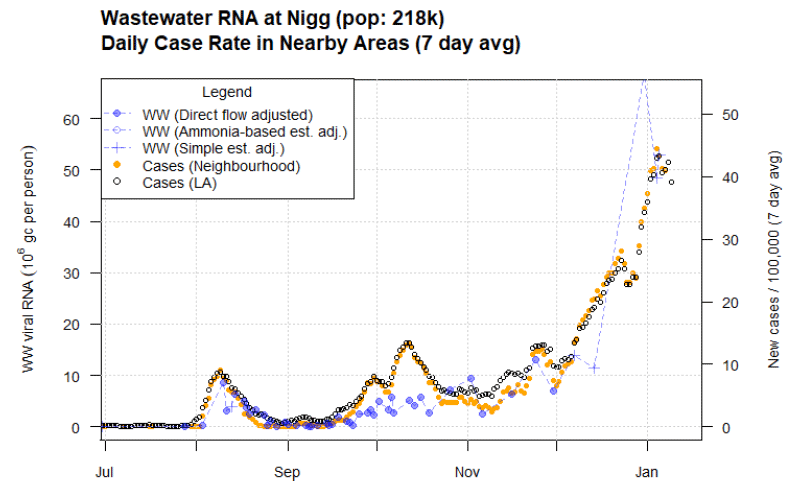
For Nigg (corresponding to Aberdeen) in Figure 10, a recent (estimated) peak of 69 Mgc/p on 31 December 31 falls outside of the limits of the graph. Overall, while the wastewater captures the recent case rate peak and that in August, the peak in October is less clearly shown.
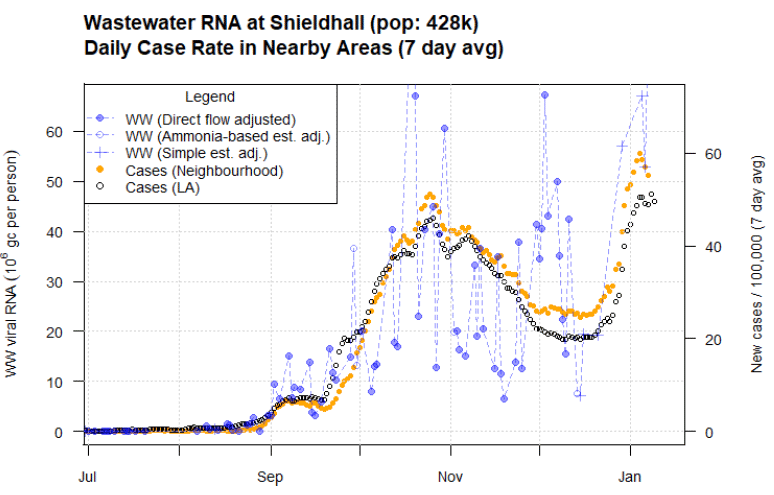
The most recent measurement is a level of 81 Mgc/p on 7 January, lying outside of the limits of the graph.
Challenges with wastewater data are evident in Figure 11 for Shieldhall (in Glasgow). Here, whilst the measurements overall reflect the changes in COVID-19 levels seen in the case data, there is considerable variability present from day to day, even after normalisation. This noise can potentially hide the underlying signal. Over the coming weeks, methods will be developed to assist interpretation.
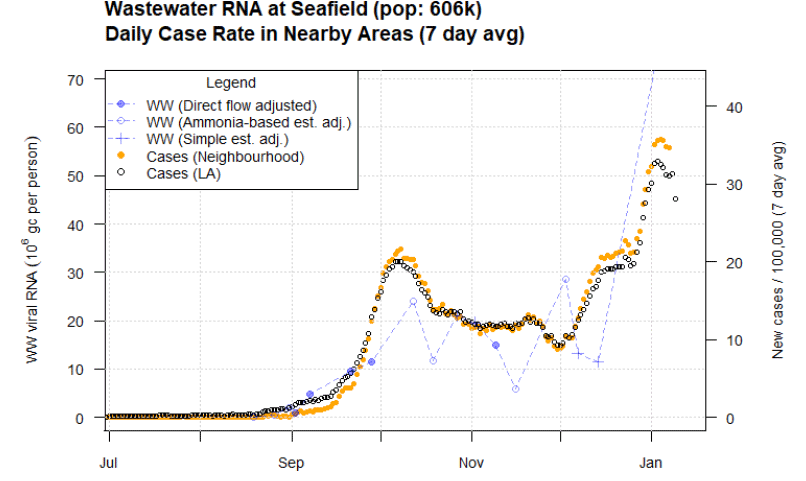
Compared to Shieldhall, Seafield (Figure 12) has in prior months lower levels of both wastewater RNA and case numbers, but in the recent period both have climbed to similar levels, with the most recent wastewater reading at a level of 79 Mgc/p on 4 January.
What next?
The Scottish Government continues to work with a number of academic modelling groups to develop other estimates of the epidemic in Scotland.
The modelled estimates of the numbers of new cases and infectious people will continue to be provided as measures of the epidemic as a whole, along with measures of the current point in the epidemic such as Rt and the growth rate. Further information can be found at https://www.gov.scot/coronavirus-covid-19.
Investigations are ongoing by NERVTAG, SPI-M, SAGE and Scottish Government regarding the impact of the new variant, SARS-CoV-2 VUI 202012/01, which will be reflected here as work is undertaken.
In the coming weeks the impact of the lockdown will be reflected in the modelling.
Contact
There is a problem
Thanks for your feedback